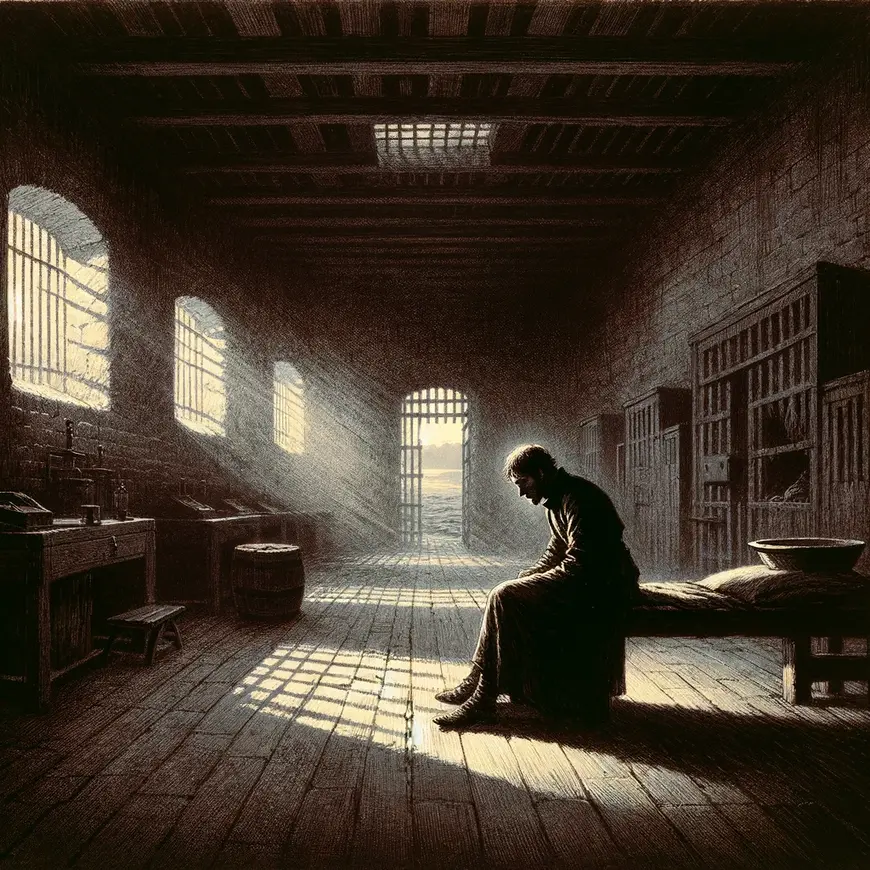The Guillotine’s Shadow – A Review of Victor Hugo’s “The Last Day of a Condemned Man”
In the realm of classic literature, Victor Hugo’s “The Last Day of a Condemned Man” stands as a poignant and gripping narrative that takes readers on a harrowing journey through the mind of a condemned man facing the guillotine. With prose that is as evocative as it is haunting, Hugo crafts a story that delves into the human psyche, the morality of capital punishment, and the eternal struggle for hope in the face of certain death.
Unveiling the Shadows of Condemnation: The World of “The Last Day of a Condemned Man”
Imagine a world where the blade of the guillotine looms large, and the condemned are left to grapple with the inexorable approach of death. “The Last Day of a Condemned Man” immerses us in this world, where an unnamed man, marked for execution, becomes the narrative’s sole focus. Hugo’s prose allows us to accompany this man on his last day, as he confronts his impending doom and reflects on the life he is about to leave behind.
The setting of “The Last Day of a Condemned Man” is stark and minimalistic, mirroring the condemned man’s isolation. Hugo’s language is both spare and vivid, creating an atmosphere that is both somber and emotionally charged.

Characters in the Shadows: A Solemn Solitude
At the heart of “The Last Day of a Condemned Man” is the condemned man himself, who remains unnamed throughout the narrative. His inner turmoil, fears, and thoughts become vessels for readers to explore themes of morality, justice, and the enduring human quest for hope. His journey, marked by despair and fleeting moments of resilience, serves as a poignant reflection of the broader human experience.
Themes of Morality, Justice, and Hope: Insights Explored
“Unraveling the tapestry of morality, justice, and hope,” Hugo seems to say, as he delves into themes that resonate deeply with the human condition. The theme of morality is central to the narrative, as the condemned man grapples with the morality of the death penalty. Hugo’s exploration of morality prompts readers to reflect on the ethical complexities of capital punishment and the broader question of society’s right to take a life.
Justice is another prominent theme that surfaces throughout the narrative. Hugo portrays the condemned man’s feelings of injustice and the arbitrary nature of his fate. The tension between the justice system and the individual’s perception of justice creates a narrative that is both thought-provoking and emotionally charged, prompting readers to consider the frailty of justice in the face of human suffering.
Hope, with its flickering presence in the condemned man’s mind, is a recurring motif in “The Last Day of a Condemned Man.” Hugo explores the enduring human capacity for hope, even in the darkest of circumstances. The narrative encourages readers to reflect on the role of hope as a source of strength and resilience in the face of impending doom.
Prose as a Dark Elegy: Hugo’s Writing Style
Victor Hugo’s writing style in “The Last Day of a Condemned Man” is a dark elegy, a blend of stark realism and lyrical introspection. His language is both spare and evocative, creating an atmosphere that is both haunting and emotionally charged. Hugo’s prose carries a weight that conveys the starkness of the condemned man’s reality and the deep emotional turmoil.
The novel’s structure is deliberate, with each section offering a glimpse into the condemned man’s thoughts and reflections. Hugo’s writing style mirrors the somber and contemplative nature of the narrative, where moments of despair and existential contemplation are punctuated by fleeting glimmers of hope, creating a narrative that is both heart-wrenching and profoundly moving.

Notable Quotes from “The Last Day of a Condemned Man” by Victor Hugo
- “A man condemned to death should die no more than once.”
- Explanation: This quote reflects Hugo’s criticism of the death penalty. It emphasizes the psychological torment that condemned individuals endure as they wait for their execution, suggesting that this mental suffering is a form of repeated death.
- “Tomorrow, at this hour, I shall be dead.”
- Explanation: This quote captures the immediacy and inevitability of the protagonist’s fate. It conveys the protagonist’s acute awareness of his impending death, creating a sense of urgency and helplessness that permeates the narrative.
- “I have been condemned to death. Everything I see from now on will be seen for the last time.”
- Explanation: This quote highlights the protagonist’s intense and poignant experience of his final days. It reflects the heightened awareness and appreciation of life that comes with the knowledge of imminent death, underscoring the tragedy of the death penalty.
- “It is the end of everything for me. There will be no more days, no more hours, no more minutes.”
- Explanation: This quote emphasizes the finality of death. The protagonist reflects on the cessation of time and existence, evoking a sense of absolute and irreversible loss, which adds to the narrative’s emotional depth.
- “The thought of death brings nothing but terror and despair.”
- Explanation: This quote encapsulates the profound fear and hopelessness that the protagonist feels. It underscores the emotional and psychological impact of facing death, highlighting Hugo’s critique of the death penalty as inhumane and barbaric.
Trivia Facts about “The Last Day of a Condemned Man” by Victor Hugo
- Publication and Reception: “The Last Day of a Condemned Man” was first published in 1829. The novel was initially met with mixed reviews, with some praising its emotional power and others criticizing its bleak subject matter. Over time, it has been recognized as a significant work in the abolitionist movement against the death penalty.
- Advocacy for Abolition: Victor Hugo wrote the novel as a strong statement against the death penalty. His detailed and empathetic portrayal of a condemned man’s final hours was intended to humanize prisoners and argue for the abolition of capital punishment. Hugo continued to campaign against the death penalty throughout his life.
- Influence on Later Works: The novel had a significant impact on later literature and discussions about capital punishment. It influenced authors like Charles Dickens and Fyodor Dostoevsky, who also explored themes of justice, punishment, and the value of human life in their works.
- Narrative Style: The novel is written in the form of a first-person diary, capturing the protagonist’s thoughts and emotions in a stream-of-consciousness style. This intimate narrative approach allows readers to closely experience the psychological torment of the condemned man.
- Hugo’s Own Experiences: Victor Hugo was inspired to write “The Last Day of a Condemned Man” after witnessing a public execution. The event profoundly affected him and reinforced his belief in the inhumanity of the death penalty. This experience fueled his determination to write a work that would raise awareness and provoke thought on the issue.
Timeless Relevance: Today’s Reflections
While “The Last Day of a Condemned Man” is firmly rooted in its specific historical context, its exploration of morality, justice, and hope remains relevant in the contemporary world. In an era marked by discussions of criminal justice reform, human rights, and the enduring struggle for hope in the face of despair, Hugo’s examination of these themes offers a timeless perspective.
The theme of morality and the morality of capital punishment continue to be subjects of debate and reflection, as societies grapple with questions of justice and ethics. Hugo’s portrayal of the condemned man’s inner turmoil serves as a reminder of the enduring complexity of moral dilemmas and the need for ethical reflection.
Justice, in the context of criminal justice reform and human rights advocacy, remains an essential theme. “The Last Day of a Condemned Man” prompts readers to contemplate the flaws and limitations of the justice system, and the enduring importance of individual perceptions of justice.
Hope, as an enduring human emotion, is a theme that resonates deeply in the contemporary world. In an era marked by challenges and uncertainties, the narrative encourages readers to reflect on the role of hope as a source of resilience and the enduring human capacity for optimism.
Final Thoughts on “The Last Day of a Condemned Man” : A Dark Journey of Human Reflection
“The Last Day of a Condemned Man” by French writer Victor Hugo is a dark journey of human reflection that invites readers to immerse themselves in the mind of a condemned man facing the guillotine. Victor Hugo’s narrative is a testament to the enduring power of literature to challenge our understanding of morality, justice, and hope, to invite us into the inner thoughts of a man on the precipice of death, and to prompt us to reflect on the timeless themes of human suffering and resilience. Hugo’s prose becomes a vessel through which readers can contemplate the complexities of morality and the human capacity for hope, even in the darkest of hours. “The Last Day of a Condemned Man” is a testament to the enduring relevance of themes that have fascinated philosophers and thinkers for centuries, and it invites us to navigate the depths of the human condition with both introspection and reverence.
More Reviews of Works by Victor Hugo
A Tale of Love and Redemption – A Review of Victor Hugo’s “The Hunchback of Notre Dame” Hugo’s Towering Masterpiece…
A Saga of Redemption and Resilience – A Review of “Les Misérables” by Victor Hugo In the realm of literature…

